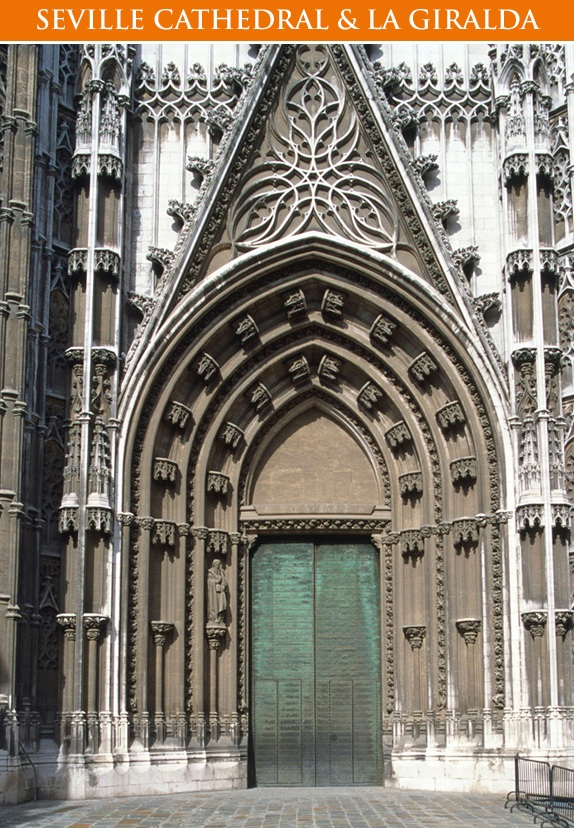
Seville Cathedral & La Giralda
In 1248, after some 500 years of Islamic culture, Seville was reconquered by Christian forces, who paradoxically threatened the Moorish inhabitants with full-scale massacre if they damaged any of the city’s magnificent edifices. Pragmatically, the conquerors simply rededicated the huge Almohad mosque to the Virgin and for about 150 years used it as their principal place of worship. In 1401, however, the momentous decision was taken to demolish the then mouldering building and erect a new cathedral of unprecedented proportions on its enormous rectangular base. In just over a century, the structure was complete, the renowned minaret now serving as the belltower.![]() Plaza Virgen de los Reyes • 954 21 49 71 • Open 11am–3:30pm Mon (Jul & Aug: 9:30am– 2:30pm); 11am–5pm Tue–Sat (Jul & Aug: 9:30am– 4pm); 2:30–6pm Sun • Guided tours and rooftop tours: www.cubiertasdelacatedral.com. • Services 8:30am, 9am, 10am, 12:30pm, 5pm, 8pm Mon–Sat; 8:30am, 10am, 11am, 11:30am, noon, 12:30pm, 1pm, 5pm, 8pm Sun • Adm €8.00
Plaza Virgen de los Reyes • 954 21 49 71 • Open 11am–3:30pm Mon (Jul & Aug: 9:30am– 2:30pm); 11am–5pm Tue–Sat (Jul & Aug: 9:30am– 4pm); 2:30–6pm Sun • Guided tours and rooftop tours: www.cubiertasdelacatedral.com. • Services 8:30am, 9am, 10am, 12:30pm, 5pm, 8pm Mon–Sat; 8:30am, 10am, 11am, 11:30am, noon, 12:30pm, 1pm, 5pm, 8pm Sun • Adm €8.00
1. Exterior and Scale
In sheer cubic vastness, Seville Cathedral is the largest Christian church in the world, and there’s a certificate from the Guinness Book of Records on display here to prove it. It measures 126 m (415 ft) by 83 m (270 ft) and the nave rises to 43 m (140 ft). The best place to take it all in is from La Giralda.
2. Puerta del Perdon
The “Gate of Pardon” is set in a crenellated wall and is the main entrance to the only surviving section of the mosque. The arch and bronze-covered doors are a masterpiece of Almohad art, carved with 880 Koranic inscriptions. There are also sculpted Renaissance elements, most notably a bas-relief depicting the Expulsion of the Moneychangers from the Temple.
3. Patio de los Naranjos
The Courtyard of Orange Trees was the place where ritual ablutions were performed before entering the mosque for prayer.
4. Cathedral Paintings
There are around 600 paintings throughout the cathedral, from the entrance pavilion to the sacristies, together with a number of sculptures from the 17th-century Sevillian School, which included artists such as Bartolomé Esteban Murillo, Francisco de Zurbarán and Francisco Pacheco.
5. Interior
Inside the cathedral the Gothic arches are so high that the building is said to have its own independent climate.
6. Capilla Mayor
The main altar’s tour de force is its 15th-century retablo, which is the world’s largest altarpiece. Composed of gilded carved wood, it boasts some 45 Biblical scenes employing some 1,000 figures.
7. Sacristia de los Calices
Part of the cathedral’s treasury is housed here. The anteroom displays the Tenebrario, a 7.8-m (25-ft) Plateresque candelabrum used during Holy Week. Inside, the star turns are a painting by Goya of Seville’s patron saints, Justa and Rufina, as well as canvases by Zurbarán, Jordaens and other Masters.
8. Sacristia Mayor
The Main Sacristy is dominated by a dome, designed in the 16th century. The centrepiece of the sacristy is a 450-kg (990-lb), 3-m (10-ft) silver Baroque monstrance created by Juan de Arfe.
9. Sala Capitular
The Chapter House contains Murillo’s Immaculate Conception in the vault and boasts a lavish marble floor.
10. La Giralda
This grand tower is the symbol of Seville, built between 1172 and 1195. It takes its name from the weathervane on top, called El Giraldillo.
Semana Santa Festivities
Seville’s Holy Week celebrations leading up to Easter (for further details see Semana Santa) are Andalucía’s richest and most renowned. Here, 57 brotherhoods (cofradías) compete to bear aloft the most well-dressed Virgin in mourning and an image from the Passion of Christ. Floats are carried by costaleros (bearers), while the processions are lead by nazarenos – penitents donning conical hoods.
Real Alcazar, Seville
This extensive complex embodies a series of palatial rooms and spaces in various styles and from various ages. The front towers and walls constitute the oldest surviving section, dating from AD 913 and built by the Emir of Córdoba, Abd el-Rahman III, most likely on the ruins of Roman barracks. A succession of caliphs added their dazzling architectural statements over the ensuing centuries. Then came the Christian kings, particularly Pedro I the Cruel (or the Just) in the 14th century, and finally the rather perfunctory 16th-century apartments of Carlos V. Much of the structure underwent major modifications as recently as the 18th century, due to earthquake damage.![]() Patio de Banderas • 954 50 23 24 • www.alcazarsevilla.org • Open Apr–Sep: 9:30am–7pm Mon–Sun, Oct–Mar: 9:30am–5pm Mon–Sun • Closed 1 & 6 Jan, Good Friday, 25 Dec • Adm €8.75
Patio de Banderas • 954 50 23 24 • www.alcazarsevilla.org • Open Apr–Sep: 9:30am–7pm Mon–Sun, Oct–Mar: 9:30am–5pm Mon–Sun • Closed 1 & 6 Jan, Good Friday, 25 Dec • Adm €8.75
1. Puerta del Leon
The entrance gate into the first courtyard is flanked by original Almohad walls. Note the Gothic and Arabic inscriptions on the interior façade.
2. Sala de Justicia
Here and in adjacent halls and courts is some of the purest Mudéjar art to be found, commissioned by Alfonso XI of Castile around 1330 and executed by craftsmen from Granada. The star-shaped coffered ceiling and fine plasterwork are quite exquisite.
3. Patio del Yeso
The secluded Court of Plaster, greatly restored, is one of the few remnants of the 12th-century palace. The delicate stucco work features scalloped arches and is set off by a shady garden with water channels.
4. Patio de la Monteria
The Hunting Courtyard has 14th-century Mudéjar decorative work – a perfect synthesis of differing cultural influences.
5. Casa de la Contratacion
These halls are where Fernando and Isabel met with the explorers of the New World.
6. Patio de las Doncellas
The Court of the Maidens commemorates the annual tribute of 100 virgins delivered to the Moorish rulers by the Christians. The azulejos (tiles) are fine examples of Granada craftsmanship.
7. Salon de Embajadores
The most brilliant room in the entire Alcázar. Its crowning glory is the dazzling dome of carved, painted and gilded wood, inscribed in Arabic as having been constructed by craftsmen from Toledo and completed in 1366.
8. Patio de las Munecas
The intimate Court of the Dolls was the living room of the palace and is named after two faces carved into the base of one of the arches.
9. Palacio Gotico
In a refurbished 13th-century Gothic structure built by Alfonso X the Wise, this palace has a rather inharmonious Renaissance styling.
10. Gardens
Moorish touches – fountains, pools, orange groves, palms and hedgerows – abound in these gardens. Concerts and events are held here on summer evenings.
Pedro I
Few Spanish kings have received such contradictory press over the centuries as Pedro I (1350–69). Called both “the Cruel” and ”the Just”, he killed his own brother in order to consolidate his position and flaunted his cohabitation with his mistress María de Padilla. The alcázar we see today is almost entirely the result of Pedro’s rebuilding programme, primarily so that he and María would have a cosy place of retreat.
